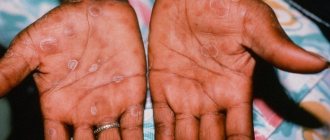Development of the disease
Syphilis is the most common sexually transmitted disease and is considered insidious and difficult to cure. For a long time it can be asymptomatic, only after a while does progression begin.
Syphilis most often appears on the penis. Treponema pallidum is considered to be the causative agent of the pathology. The disease was first recorded in our country in 1497. However, there is still not a single method that could destroy bacteria forever.
Properties of the pathogen and methods of transmission
As mentioned above, the causative agent of the disease is treponema. Bacteria multiply quickly, as a result of which they can affect internal organs. In addition, microorganisms live in large numbers on the mucous membranes.
Having had an infection once, stable immunity to it does not arise, which means that the likelihood of re-infection is high. Bacteria are not resistant to the external environment and die almost instantly when boiled. At a temperature of 55 degrees, treponema will completely dissolve in 15 minutes.
In addition, the infection does not tolerate dry environments. Its other properties:
- if frozen, the viability of bacteria will be maintained for a year;
- Bacteria can live in moisture residues on dishes for several hours;
- You can become infected from the corpse of a syphilitic patient; the bacteria will live for four days.
There are several ways of transmitting the disease, among them are:
- through saliva - rare, more common for dentists who perform their work without gloves;
- through household items, but only on the condition that there are ulcers or gummas on the patient’s body;
- vertical route - infection occurs in the prenatal period;
- through blood - during transfusion, due to cuts with razor accessories;
- during sexual intercourse - the most common method.
Most often, syphilis on the head of the penis appears precisely because of unprotected sexual intercourse.
The cause of infection is the lack of contraception
Incubation period
After treponema enters the human body, it is immediately sent to the circulatory and lymphatic system, after which it begins to spread throughout the body. However, a man who has just become infected may feel well for a long time and will not have any symptoms of the disease.
From the moment infection occurs, it can take from 8 to 107 days, but as practice shows, the average period lasts no more than 40 days. Thus, syphilis does not manifest itself in any way for a month and a half or a little less. Even if you take blood tests, the disease will not be detected.
Due to some factors, the duration of the incubation period can be increased:
- taking certain medications: antibiotics, corticosteroids, etc.;
- the patient's condition in which the temperature is elevated for a long time;
- elderly age.
If there is a mass infection, the incubation period will not last long. Important! During this entire time, the patient will be infectious to others, but infection can occur exclusively through blood.
Treatment of syphilis in men
The first medicine to treat a terrible disease was invented by Paracelsus. The greatest physician of the Middle Ages did not know that treponema pallidum was sensitive to compounds of mercury, arsenic, bismuth and iodine, but he noticed that the mercury ointment, which he rubbed into the legs of patients, slowed down the course of the disease. Those infected in the USSR were treated with mercury preparations until 1963. However, the effectiveness of this technique left much to be desired. The toxicity caused patients to lose hair and develop serious complications. Since 1943, doctors began to introduce effective and non-toxic penicillin drugs into clinical practice.
Diagnostics
The diagnosis of syphilis is made after a careful study of the clinical picture and is confirmed in the laboratory. To do this, blood tests and sometimes cerebrospinal fluid tests are taken. Today, the following methods are used to diagnose syphilis:
- serodiagnosis and PCR;
- Wasserman reaction (obsolete);
- linked immunosorbent assay.
You can test for syphilis at home. The tests are sold in regular pharmacies.
Today, syphilis is diagnosed relatively rarely: the vicious circle of infection interrupts people's awareness and choice of safe sex. Photo: Pixabay
Modern methods of treating syphilis
Treponema pallidum has maintained sensitivity to penicillin and drugs based on it for centuries. Therefore, antibiotics are the only effective way to treat patients.
If syphilis is detected, all sexual partners of the infected person are also treated.
“Of course, today this disease is diagnosed less frequently,” says dermatovenerologist Azamat Kintaev . – Venereologists themselves explain this by the uncontrolled use of antibiotics in the treatment of other diseases, which muffles the manifestation of syphilis, but aggravates its latent forms. In this case, syphilis can be determined only by a blood test, without any clinical manifestations of the disease. The increase in incidence is also reduced by people's increased awareness of the need for safe sex, in particular using condoms, which prevents infection with many dangerous sexually transmitted infections, including syphilis.
Preventing syphilis at home
These tips may have set your teeth on edge by now, but they work:
- avoid casual sex;
- use a condom (does not protect 100% as foci of infection may be on the oral mucosa or other uncovered areas of the body).
The causative agent of syphilis is very sensitive to traditional antiseptics and soaps. Therefore, if a “casual relationship” does take place, the following procedures will help reduce the risk of infection:
- urinate;
- wash your hands and external genitalia with soap;
- treat the genitals, pubis and thighs with miramistine or chlorhexidine or betadine.
Important! The described measures are effective no later than 2 hours after sexual intercourse!
What to do if there is a patient with syphilis at home:
- use separate utensils and personal hygiene products;
- Avoid kissing during the contagious stage.
It is generally accepted that the saliva of patients with syphilis is contagious only if they have rashes on the oral mucosa.
“If a person has become infected with syphilis, he must maintain strict hygiene: he must have separate dishes, a towel, manicure accessories, his toothbrush must be kept separately,” advises dermatovenerologist Azamat Kintaev .
Symptoms of the disease
The first symptoms begin to appear immediately after the incubation period, the man is concerned about the following:
- Sores begin to form;
- on the affected areas there is bright red hypermia;
- ulcers have clear boundaries;
- the size of the affected areas is no more than four centimeters.
Syphilis of the genital organs can affect not only the penis; ulcers can be found in the anus, as well as in the diuretic ducts. Because the disease is contagious, the symptoms can be very worrying. The photo below is an example of the development of pathology.
Lesion of the penis
In particularly severe cases, numerous complications may occur:
- the head of the penis and other affected areas swell;
- the foreskin becomes thicker;
- tissue death occurs.
The tissue structures on the penis die because the head of the penis is pinched by swollen areas on the mucous membranes and skin.
Symptoms of primary syphilis
After the stage of the incubation period is completed, the next one begins, namely, the primary one.
During this period, the following signs appear:
- Syphilomas are formed . The formation is no larger than one centimeter in size, there is no pain or other sensations. The glans penis and foreskin are most often affected.
- A hard chancre begins to form.
- Lymphadenitis appears - at this stage of development, the lymph nodes increase in size, but only those that are located close to the affected area.
If at this stage the patient was not provided with timely medical care, the disease will begin to move into the next stage of development.
Treponema pallidum - the causative agent of the disease
Chancre
Hard chancre is a small ulcer, in most cases it is localized in the genital area.
A hard chancre appears in the place where the pathogen entered the body:
- glans penis;
- scrotal area;
- bridle.
A hard chancre forms within one to two weeks after the pathogen enters the body.
Visual manifestations of chancre may be atypical:
- Felon. Such formations cause discomfort and pain. A necrotic coating appears on their surface, and after some time erosion begins to form.
- Induactive edema. The erosions become bluish in color and severe swelling appears.
If syphilis is noticed on the genitals in the form of a spot, you should go to a medical facility for examination as soon as possible. With timely assistance, chancroid can be successfully treated.
Secondary syphilis
If three to four months after infection no help has been provided, the second stage of the disease will begin to develop.
Symptoms are characterized as follows:
- a pale rash appears on many areas of the skin;
- lymph nodes increase in size;
- the appearance of severe pain in the head, dizziness may occasionally bother you;
- the patient becomes very tired, the general condition is weakened;
- possible increase in body temperature;
- hair falls out, and sometimes conjunctivitis develops.
The nature of the second stage is periodic. Symptoms appear and disappear, after which they make themselves felt again.
Important! If symptoms disappear, you should not rely on self-healing; it is impossible under any circumstances.
Spread of the disease further throughout the body
Syphilis on the penis at this stage can cause the development of early neurosyphilis.
Signs accompanying it:
- an inflammatory process affecting the blood vessels of the brain develops;
- the central nervous system suffers;
- meningitis may develop.
As mentioned above, all sorts of symptoms may be absent for a long time.
Symptoms of tertiary syphilis
It may take many years until the disease reaches the third stage of development. Immediately after the secondary stage, a latent period begins, during which time there are no signs. However, there are many cases where there are no complications, and the person simply continues to be a carrier of the pathology.
More than 30% of patients reach the tertiary stage; it can be diagnosed due to the manifestation of the following signs:
- neurosyphilis develops - treponema affects the central nervous system;
- the functioning of internal organs and systems is disrupted; in the presence of concomitant diseases in the chronic stage, they can worsen;
- paralysis – limbs are paralyzed, dementia develops;
- tabes dorsalis - there are problems with orientation, difficulty walking.
Large vessels may be affected. In 25% of cases, complications of tertiary syphilis lead to the death of the sick person.
Consequences and prognosis
Regardless of whether syphilis manifests itself or not, in any case it has a negative effect on internal organs. The list of complications of syphilis includes the following:
- damage to the cardiovascular system;
- damage to the central nervous system;
- neurological deficits;
- impairment of intellectual abilities and memory;
- blindness;
- hearing loss;
- meningitis.
Development is possible:
- IHD;
- gastritis;
- hepatitis, up to coma and death;
- osteoarthritis;
- syphilitic pneumonia.
In the primary form of syphilis in men, the following may appear:
- phimosis;
- balanoposthitis;
- gangrene of the genital organ;
- balanitis
As for the prognosis of the disease, it depends on the stage of the disease and the effectiveness of treatment. With primary and secondary syphilis, the treatment prognosis is favorable; the third stage can lead to disability of the patient.
With congenital syphilis, the prognosis for treatment is positive, but only if adequate treatment is started immediately.
Diagnostics
In order to know for sure that the presenting symptoms indicate the development of syphilis, it is necessary to undergo diagnostics.
Carrying out diagnostics
Scraping to identify Treponema pallidum. The oral mucosa can be a favorable environment for the proliferation and habitat of bacteria. A sample removed from an ulcer helps to examine the bacteria under a microscope without additional staining or auxiliary enzymes.
The next diagnostic method is bacteriological examination. A swab is taken from the urethra, the results allow you to identify an infection in the urinary tract.
Urethroscopy is an endoscopic examination of the bladder. The procedure can only be performed by an experienced doctor. The results make it possible to identify the presence of an inflammatory process, and you can also assess the condition of the urethra.
Late forms of syphilis: current state of the problem
Syphilis occupies an important place in the structure of sexually transmitted infections (STIs) and is a socially significant disease, since it not only causes great damage to the health and reproductive function of the patient, but also poses a threat to the economic and social potential of the country [1–7]. 1990s in the Russian Federation were marked by a real epidemic of syphilis, comparable in terms of indicators only to the distant pre-penicillin era. Currently, the situation has stabilized, however, against the backdrop of a constant decrease in overall morbidity, there is a noticeable upward trend in the number of patients with late forms [1, 8–10]. In the Republic of Tatarstan, the proportion of patients with late syphilis increased from 1991 to 2014 by 120 times.
In late forms of syphilis, the few treponema pallidum preserved in the tissues gradually lose their antigenic properties and the leading role passes to the reactions of cellular immunity. Against the background of a decrease in humoral immunity, the intensity of the humoral response decreases and the number of specific antibodies decreases, which is accompanied by the negativity of serological tests, primarily non-treponemal tests, of which the microprecipitation reaction (MPR) is currently used [8, 11–13]. Our analysis of the incidence of late syphilis from 1991 to 2013. (901 patients) found that most of these patients (68.8%) were identified in the period from 2005 to 2014 after the introduction in 2005 of serological testing using enzyme-linked immunosorbent assay (ELISA) and passive hemagglutination test (RPHA). At the same time, the MCI result of the observed patients was negative in 65.7% of cases. Almost all patients were infected during the syphilis epidemic in the 90s. XX century. The lengthening of the diagnostic route in the vast majority of cases was caused by antibiotic therapy, the reasons for which were prescribed were quite diverse. In 5.0% of cases, patients received preventive treatment in the past (always with durable penicillin drugs) as contacts of syphilis, in 7.3% they were treated for other STIs, in 13.4% they self-medicated or turned to medical professionals, in 17.8% - antibiotics were prescribed as therapy for intercurrent diseases. 22.8% had previously suffered syphilis, of which 85.0% of patients received treatment with durant drugs. And finally, a small part (4.1%) was observed by dermatovenerologists with a diagnosis of “false-positive serological reactions.” Only a third (29.6%) of patients had never had syphilis or been treated with antibiotics before they were diagnosed with a late form of syphilitic infection. It is noteworthy that before the diagnosis was made, a third of the patients in the observed group (35.6%) were tested using MRP methods and a complex of serological reactions (SSR) from once in a lifetime to several times a year with a negative result.
According to our data, of all clinical variants of late syphilis, the latent form currently prevails (83.0%). Late syphilis with symptoms most often manifests itself as damage to the nervous (13.6%) and cardiovascular (2.7%) systems. Late lesions of the nervous system are mainly diagnosed as a pathological process in the blood vessels of the brain, which is accompanied by epileptoid seizures, sensory and speech disorders, and ischemic strokes. Proliferative changes and gummas in the tissue of the brain or spinal cord occur in episodes. Cardiovascular late syphilis is often defined as uncomplicated syphilitic aortitis or syphilitic aortitis complicated by stenosis of the coronary artery ostia and aortic valve insufficiency.
Patients diagnosed with “other symptoms of late syphilis” or the more familiar terminology “tertiary syphilis” are now extremely rare. Tertiary syphilis (syphilis III tertiaria), called by A. Fournier “the most unfortunate station where the most important and severe manifestations of the disease occur,” at the end of the 19th century occupied 59.4–87.0% of all its forms [4, 9, 14]. In 1911, its share in Russian cities was 29.6%, in villages - 55.9%, in 1921 - from 33.0 to 77.0% in various regions of the RSFSR [1]. After the introduction of arsenic drugs into the arsenal of antisyphilitic therapy, and then antibiotics, the registration of the tertiary form began to decrease noticeably in the 70–80s. last century accounted for only 3.2% of the total incidence of syphilis [4, 9, 15]. Currently, tertiary syphilides are rare, since treatment with penicillin in early forms prevents the post-epidemic increase in later manifestations. No less significant reasons for the decline are active dispensary work and mass screening events carried out in the USSR after the outbreak of syphilitic infection in the 1970s, as well as the widespread and uncontrolled use of antibiotics by the population [4, 15–17]. In the Russian Federation, 5 cases of gummous syphilis were diagnosed in 2007, and none in 2008. However, after the introduction of durable penicillin drugs into practice, an increase in late forms with clinical symptoms is expected, as has already been reported in the domestic and foreign literature. The return of gummous syphilis, tabes dorsalis and progressive paralysis can also be caused by the association of Treponema pallidum with pathogens of other STIs, especially with the human immunodeficiency virus (HIV), which is confirmed by N. S. Potekaev (2004), who observed an HIV-infected patient with diffuse gummous meningoencephalitis [10, 18–22]. In the Republic of Tatarstan, the last registration of the gummous form was in 1960. However, in 2009, 2 cases of this clinical variant of the infection were diagnosed.
Clinical manifestations of late syphilis are destructive lesions of the skin, bones, joints, internal organs and nervous system (Fig. 1–3). The human psyche also changes significantly. Patients become “strange”, suffer from mental instability, and may experience hallucinatory delusions [1, 14, 20]. On the skin and mucous membranes, syphilides appear as tubercles or gummas. Lesions of the musculoskeletal system are severe and are accompanied by destructive changes, mainly in the bones of the legs, skull, sternum, clavicle, ulna, nasal bones, etc. Late syphilis of the bones manifests itself in the form of osteoperiostitis or osteomyelitis. Osteoperiostitis can be limited and diffuse. Limited osteoperiostitis develops more often and is a gumma, which in its development either ossifies or disintegrates and turns into a typical gummous ulcer. After some time, sequestration appears; less often, the bone gum becomes ossified. Healing ends with the formation of a deep retracted scar. Diffuse osteoperiostitis is a consequence of diffuse gummous infiltration. It usually ends with ossification with the formation of calluses. With diffuse gummous osteoperiostitis, the changes are similar to a limited process, but more widespread, in the form of a fusiform, tuberous thickening. They are especially noticeable in the middle part of the crest of the tibia and ulna. With osteomyelitis, the gumma either ossifies or a sequester forms in it. Patients complain of pain that worsens at night and when the affected bones are tapped. Sometimes sequestration leads to the development of a gummous ulcer. The process involves the periosteum, cortical, spongy and medulla with destruction of the central part of the lesion and the occurrence of reactive osteosclerosis along the periphery. Subsequently, the cortical layer of the bone, periosteum, and soft tissues are affected, a deep ulcer is formed, bone sequesters are released, the bone becomes fragile, and a pathological fracture may occur. The radiograph shows a combination of osteoporosis and osteosclerosis. Morphologically, productive necrotic inflammation is observed with the formation of tubercles, gummas (syphilitic granuloma) and gummous infiltrates. Gumma and tubercular syphilide are infectious granulomas, accompanied by pronounced changes in the blood vessels. Gumma is an extensive area of coagulative necrosis, the edges of which consist of large fibroblasts, reminiscent of epithelioid cells in tuberculosis. There is an inflammatory mononuclear infiltrate of plasma cells and a small number of lymphocytes around. Langhans giant cells are very rare. In gummous infiltrates, a typical picture is observed with the formation of perivascular inflammatory couplings. In vessels, especially large ones, proliferation of the endothelium is noted, up to their obliteration. Sometimes in the neighborhood there are microscopic granulomas, which in their structure are practically no different from tuberculous and sarcoid granulomas.
Verification of syphilitic organ damage in the late period presents certain difficulties, since clinical manifestations are scarce, and serological reactions are informative only in 65–70% of cases. In addition, doctors often make diagnostic errors, while patients receive a variety of treatments, including surgical ones, which are contraindicated for them and do not give the desired effect.
As an example, we give our own observation.
Patient L., born in 1967 (46 years old), single, promiscuous, alcohol abuser, in 2006 (7 years ago) consulted a local physician with complaints of weakness in the knee and elbow joints, headache, dizziness. At the local clinic, after carrying out the express examination for syphilis recommended by the standards, a positive result was obtained, and therefore the patient was sent to the regional dermatovenerological dispensary (DVT). Upon examination, no manifestations of syphilis were found on the skin and mucous membranes. At the same time, the patient had objective neurological symptoms, which did not attract the attention of a dermatovenerologist. A diagnosis was made: latent early syphilis, treatment was carried out with medium-duration penicillin (Bicillin-3). After completing the course of specific therapy, L. was under clinical and serological control for a year, which he interrupted on his own. Until the fall of 2013, I did not test for syphilis. Despite pronounced changes in the joints and nasal septum, he did not seek medical help. Only in September 2013, when applying for a job, was he examined serologically with a positive result of all tests (MRP 3+, ELISA Pol., RPGA 4+ from 09/06/13). Pre-hospital examination at the regional hospital allowed us to suspect late syphilitic damage to the nervous system and musculoskeletal system in L. The patient was hospitalized in the inpatient department of the hospital.
Upon admission: visible skin and mucous membranes are pale, without rashes. Peripheral lymph nodes are not enlarged. Facial muscles are hypotrophic. The range of motion in the cervical spine is sharply limited - head rotation in both directions is no more than 10 degrees. Movements in the shoulder, elbow and knee joints are severely limited, the joints are deformed and thickened. The muscles of the limbs are hypotrophic. Proprioreflexes are increased, d = s, except for the Achilles, which are decreased, d ≤ s, sensitivity is not changed.
Complete blood count: erythrocytes 2,190,000, hemoglobin 60 g/l, color index 0.82, leukocytes 7,600, eosinophils 1%, band leukocytes 2%, segmented leukocytes 80%, lymphocytes 12%, monocytes 5%, ESR 65 mm /h.
General urine test and biochemical blood test are within normal limits.
Serological examination: blood MCI 4+, ELISA positive, RPGA 4+; CSF MRP is negative, ELISA is positive, RPGA 4+, RIF-200 4+.
X-ray of the elbow and knee joints: on both sides - a sharp narrowing of the joint spaces, sclerosis and massive ecostoses of the articulated surfaces, gummous periostitis of the anterior surface of the ulna, destruction of the bone tissue of the humerus. Conclusion: syphilitic lesion of both elbow and knee joints (periostitis, osteomyelitis, arthritis).
Consultation with an ophthalmologist: retinosclerosis.
Consultation with an otorhinolaryngologist: extensive perforation of the nasal septum.
Consultation with a therapist: severe hypochromic anemia of unspecified origin.
Consultation with a neurologist: neurosyphilis with bulbar manifestations of pyramidal insufficiency.
Based on these data, a diagnosis was made: late neurosyphilis with symptoms A52.1.
Other symptoms of late syphilis (bone syphilis, gumma, synovial syphilis) A52.7.
The patient received 2 courses of specific therapy: benzylpenicillin sodium salt crystalline, 12 million units intravenously, 2 times a day, 20 days, break 2 weeks. During treatment, general health improved, headaches and joint weakness decreased.
This observation indicates that insufficient awareness of specialists about the clinical features of syphilitic infection in its late manifestations can have very dangerous consequences. It is especially depressing that the lengthening of the diagnostic route was due to the fault of the dermatovenerologist. The patient’s negative attitude towards his own health, possibly provoked by the disease, and the inadequate actions of the attending physician led to a severe, crippling outcome.
When determining the causes of damage to internal organs and the central nervous system, a correctly collected anamnesis is invaluable, which must include the following information.
- Syphilis suffered in the past.
- Any options for antibacterial therapy.
- Results of previous syphilis testing, if performed.
- Other past illnesses.
- Dispensary observation by specialists of other profiles.
- In women: the presence of inflammatory processes in the reproductive organ system; and the number and outcome of previous pregnancies.
- Typical complaints.
- Results of special studies and consultations of related specialists, if any.
Particular caution should be exercised in relation to patients under 40 years of age who have not recently suffered from any somatic diseases. We remind you that any clinical variant of late syphilitic infection is an indication for cerebrospinal fluid examination!
All of the above allows us to conclude: today the problem of syphilis remains as relevant as it was many centuries ago. Nowadays, the clinical manifestations of late syphilis are as diverse as in the pre-penicillin era. Underdiagnosis of late forms sometimes leads to quite severe and sometimes tragic consequences. It is noteworthy that many doctors continue to emphasize and verify syphilis only based on the results of serological tests. Insufficient awareness of specialists about the clinical features of syphilitic infection in its late manifestations makes it necessary to change the direction of organizational work with them, as well as more active intervention of dermatovenerologists in the diagnostic process. The introduction of serological methods such as ELISA and RPGA into laboratory examination makes it possible to optimize the diagnosis of syphilis not only in its early but also late manifestations. The increase in the incidence of latent, visceral forms, congenital and neurosyphilis indicates the undoubted relevance of the problem and determines the control of syphilitic infection as a priority in global health. Under these conditions, a scientifically based approach is needed to analyze the constantly changing situation of the spread of syphilitic infection in different age and professional groups and different regions.
Literature
- Dmitriev G. A., Dolya O. V., Vasilyeva T. I. Syphilis: phenomenon, evolution, innovation. M.: Binom. 2010. P. 367.
- Kubanova A. A., Lesnaya I. N., Kubanov A. A. et al. Development of a new strategy for controlling the spread of sexually transmitted infections in the Russian Federation // Bulletin of Dermatology and Venereology. 2009. No. 3. P. 4–12.
- Kubanova A. A., Melekhina L. E., Kubanov A. A. et al. Incidence of congenital syphilis in the Russian Federation for the period 2002–2012. // Bulletin of dermatology and venereology. 2013. No. 6. pp. 24–32.
- Milich M.V. Evolution of syphilis. M.: Medicine, 1987. 159 p.
- Chebotarev V.V. Syphilis. Monograph. Stavropol. 2010. P. 444.
- Department of Health and Human Services, Centers for Disease Control and Prevention. Sexually transmitted diseases treatment guidelines // MMWR. 2006. Vol 55. 94 p.
- Lewis DA, Young H. Syphilis // Sex Transm. Infect. 2006. 82 (Suppl IV). R. 13–15.
- Katunin G.L., Frigo N.V., Rotanov S.V. et al. Analysis of the incidence and quality of laboratory diagnostics of neurosyphilis in the Russian Federation // Bulletin of Dermatology and Venereology. 2011. No. 3. pp. 18–26.
- Mavlyutova G.I., Yusupova L.A. Damage to internal organs in early and late forms of syphilitic infection. Training manual for doctors. Kazan: Alfa-K LLC, 2014. 55 p.
- Moskvin I.P., Brzhozovskaya M.G., Lukina Yu.S. Gumma of the spine as a manifestation of tertiary syphilis // Bulletin of Dermatology and Venereology. 2007. No. 1. pp. 33–36.
- Runina A.V., Khairullin R.F., Rog K.V. et al. New recombinant antigens Treponema pallidum Tr0453 and Tr0319 in the diagnosis of syphilis // Bulletin of Dermatology and Venereology. 2014. No. 3. pp. 72–79.
- Frigo N.V., Manukyan T.E., Rotanov S.V. et al. Diagnosis of early forms of syphilis by immunochemiluminescence // Bulletin of Dermatology and Venereology. 2013. No. 3. pp. 66–73.
- Herring A., Ballard R., Mabey D., Peeling RW WHO/TDR Sexually Transmitted Diseases Diagnostics Initiative. Evaluation of rapid diagnostic tests: syphilis // Nat Rev Microbiol. 2006. 4 (12 Suppl). R. 33–40.
- Ge A.G. Course of venereal diseases. Kazan, 1903. 598 p.
- Mavlyutova G.I., Yusupova L.A., Minullin I.K. Practical aspects of the evolution of clinical markers of syphilitic infection. Training manual for doctors. Kazan: Medok, 2013. 36 p.
- Hama K., Ishigushi N., Tuji T. et al. Neurosyphilis with meziotemporal magnetic resonance imaging abnormalities // Intern med J. 2008. No. 47. R. 1813–1817.
- Young A., Mc Millan A. Syphilis and the endemic treponematoses. In: McMillan A., Young H., Ogilvie MM, Scott GR Clinical Practice In: Sexually Transmissible Infections. Elsevier Science Limited, London. 2002. R. 395–459
- Musher DM Syphilis, neurosiphilis, penicillin, and AIDS // J. Infect. Dis. 1991. V. 163 (6). P. 1201–1206.
- Norris SJ, Pope V., Johnson RE, Larsen SA Treponema and other human host-associated spirochetes. In Murray PR, Baron EJ, Jorgensen JH, Pfaller MA, Yolken RH, eds. Manual of Clinical Microbiology. Washington DC: American Society for Microbiology. 2003. R. 995-10-71.
- Parc S. E. Manifestations and treatment of ocular syphilis during an epidemic in France // Sex Transm Dis. 2007. V. 34, No. 8. P. 553–556.
- Young A., Mc Millan A. Syphilis and the endemic treponematoses. In: McMillan A., Young H., Ogilvie MM, Scott GR Clinical Practice In: Sexually Transmissible Infections. Elsevier Science Limited, London. 2002, pp. 395–459.
- Monteiro F., Julião B. Oral Manifestation of Tertiary Syphilis // Case Report. Braz. Dent. J. 1999. V. 10 (2). P. 117–121.
G. I. Mavlyutova1, Candidate of Medical Sciences L. A. Yusupova, Doctor of Medical Sciences, Professor A. G. Misbakhova, Candidate of Medical Sciences
GBOU DPO KSMA Ministry of Health of the Russian Federation, Kazan
1 Contact information
Treatment methods
If symptoms similar to the development of syphilis are detected, you should go to the hospital as soon as possible. Examination and treatment are carried out by a dermatovenerologist. The disease takes a long time to be treated. At the primary stage, you will need to undergo a course of treatment lasting two to three months. At the secondary stage, therapy can last more than two years.
A ban on sexual relations is imposed for the entire period of treatment. Therapy must be comprehensive, selected individually for each patient. The basis of therapy is antibiotics, thanks to which the prognosis for recovery is almost always favorable.
Today penicillin derivatives are used. Instructions for taking medications are given by your doctor. You cannot interrupt the course of therapy, otherwise no effect will be achieved.
At the discretion of the attending physician, additional treatment may be prescribed: physiotherapy, vitamins, immunomodulators, probiotics. You can not only have sex during the entire treatment period, but also drink alcohol.
Consequences
The result of treated syphilis is most often a weakened immune system and problems with the endocrine system. After treatment, a so-called trace reaction remains in the blood; it may not disappear until the end of life.
If the disease was detected but not cured, complications will begin to develop.
At a late stage of development of syphilis, the consequences may be as follows:
- The appearance of gummas is the formation of large ulcers on the skin and inside. Many gummas can dissolve without leaving any trace behind. In another case, syphilitic ulcers form, as a result of which the tissues soften and collapse. A sick person begins to rot alive.
- Damage to the nervous system. Meningitis, neuritis, and tabes of the spinal cord develop. In some cases, the patient is completely paralyzed.
- Neurosyphilis is a disease that affects the brain and its membrane.
The man becomes unable to work. The prognosis in this case is unfavorable and can lead to the death of the patient.
How to take a blood test for latent syphilis
Pregnant women, donors, certain categories of workers (medical personnel, cooks), and patients before a planned operation are required to take a test for syphilis. A positive test result for syphilis does not always mean that a person has an STD. Tests may be false positive for acute and chronic diseases, recent vaccination and some other conditions. This is explained by the fact that the patient’s blood contains immunoglobulins, which are similar to antitreponemal antibodies. Hence the false positive result for syphilis. In such cases, to obtain reliable results, a repeat test is carried out - determining not antibodies in the biomaterial, but the pathogen itself (treponema).
However, it is impossible to determine latent syphilis or its late forms by direct methods, therefore in clinical practice they are used exclusively to confirm the diagnosis. How to take a blood test for latent syphilis? For this purpose, indirect methods are used, for example the well-known RW (Wassermann reaction). However, more modern methods are now used: microprecipitation reaction (RMR) and RPR test (RPR).
Prevention of syphilis
The disease is most often transmitted through sexual contact, which means the main preventive measures are as follows:
- It is not recommended to enter into close relationships with unfamiliar partners;
- Regardless of the degree of trust in your partner, it is recommended to use condoms;
- It is recommended to undergo preventive examinations in the hospital several times a year;
- At the first appearance of suspicious symptoms, you should go to the hospital.
Of course, such measures do not provide one hundred percent protection, but it is still possible to avoid infection.
Syphilis on the head of the penis is unpleasant and dangerous. If you have a disease, it is forbidden to self-medicate; it not only will not help, but can also cause the development of other complications. If therapy takes place in the hospital and it was started in a timely manner, then the prognosis is favorable.
Syphilitic rupee
One type of syphilitic ecthyma is syphilitic rupee.
It occurs in weak patients.
Characterized by the severe general condition of the patient.
Often combined with inflammatory lesions of the eyes, nasal mucosa, bones, etc.
Rupa occurs in the same way as ecthyma.
The difference is that underneath the crust, rapid tissue breakdown continues.
As a result, it is constantly increasing.
Over time, it can reach sizes up to 8 cm in diameter and up to 3 cm in depth.
When you press on the crust, pus is released.
There is an ulcer underneath.
After it heals, a large scar remains.
It may be pigmented at first and then colorless.
Rupees are usually single.
They develop slowly and last a long time.
Rupees can occur not only in the secondary period of syphilis, but also in the tertiary stage.
FAQ
Can a man who has had syphilis have children?
Maybe. If the disease is cured, then there are no contraindications to conception after 3 years without relapse.
Doctor's answer from the site https://03online.com/news/mozhno_li_rodit_zdorovogo_rebenka_esli_partner_bolel_sifilisom/2014-6-12-25108:
Is reinfection possible?
Yes. The developed cellular immunity is only enough to prevent the formation of primary syphilide. Treponema spreads throughout the body, affecting internal organs, skin and mucous membranes. Such immunity is called non-sterile.
Is it possible to cure syphilis at home?
If we get lucky. It makes no sense to risk your health by taking antibiotics yourself. Medical supervision is required. Treponema can be driven into a dormant form or the disease can be transferred to the chronic phase. In case of relapse, the negative consequences for health and appearance will be irreversible.
Causes of the disease
The causative agent of syphilis is Treponema pallidum or Treponema pallidum.
This bacterium resembles a spiral in shape, it can move, and reproduces by division. When it enters the body, it settles in the lymph nodes. It begins to show up in the blood much later. Treponema is practically unviable in the environment. It does not tolerate heat, light, or drying, but at room temperature it remains mobile for up to 12 hours. Sensitive to antibiotics and almost all antiseptics. But treponema tolerates low temperatures well. It is an anaerobic - it does not require oxygen to live and reproduce.
Most often, syphilis is transmitted sexually, which makes it possible to classify it as a sexually transmitted disease. This method of infection accounts for up to 98% of all diagnosed cases.
However, there are known facts of transmission from an infected person, as well as among drug addicts who use the same syringe when injecting drugs, in everyday life when using toothbrushes or razors with blood residues on them.
Household transmission of syphilis is extremely rare and most often occurs through close contact with a patient who already has tertiary syphilis. Treponema pallidum is found in saliva only in the presence of ulcers in the oral cavity, but is absent in urine, sweat and feces.
The cause of syphilis infection can be the milk of a woman nursing her baby. There are also known cases of transmission of the disease from a patient to a fetus during pregnancy.
Chancre
A chancre visually represents a small ulcer, often located in the genital area.
Hard chancre appears in places where the pathogen enters the human body:
- on the head of the penis;
- on the scrotum;
- on the bridle.
The formation of hard chancre occurs within 7-21 days after treponema enters the body.
Visually, chancre may have atypical manifestations:
- Felon. Education hurts. There is a necrotic plaque on the surface. Later, erosions form.
- Induactive edema. The formation takes on a bluish tint and is accompanied by increased swelling.
Signs of primary syphilis on the penis
After completion of the incubation period of the pathogen in the male body, the stage of primary syphilis begins.
This period is characterized by a certain course and its symptomatic manifestations:
- Formation of syphiloma. This process reflects the immunological reaction to the invading pathogen. Symptoms:
- does not exceed 1 cm in size;
- does not cause pain;
- localized on the foreskin or on the head.
- Formation of chancre.
- The appearance of lymphadenitis. This stage is characterized by enlarged lymph nodes that are close to the affected area.
If highly qualified help is not received during this period, then syphilis goes into the second stage.
How contagious are acne with syphilis?
The infectiousness of secondary syphilides is very high.
Especially ulcers and erosions that are not covered with a crust.
These elements contain a large number of pale treponema.
They can penetrate not only into the mucous membrane, but into the skin.
Not only sexual contact, but also close household contact in a person with active rashes can lead to transmission of infection.
In addition to the direct route, there is also an indirect route of infection.
In this case, Treponema pallidum is transmitted through common objects.
For example, through clothes, towels, etc.
That is, through objects that first come into contact with the skin of a patient, and then of a healthy person.









